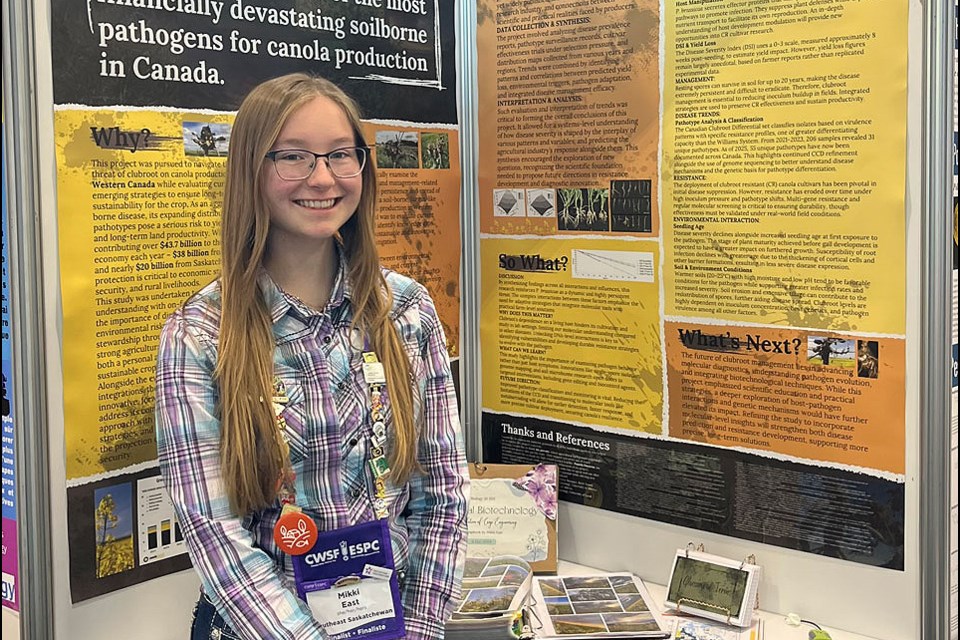ALAMEDA — What started out as a science fair project for recent Alameda grad Mikki East has turned into something she hopes to continue to study.
East’s project started with having to do something for Physics and Chemistry 30.
“With that, there is a certain project within the curriculum that you have to do. Since I had both courses, I would have had to do two student-directed semester-long projects,” explained East.
“I didn't want to do two because it was already such a heavy load,” continued East. “I was able to do a science fair project instead of a different student-directed study that would fit under these categories that branched between both my sciences.”
The previous semester, East did a study entitled Agricultural Biotechnology where part of it looked at genetically engineered (GE) canola.
This then led to East’s study of club root in canola.
“It’s a soil-borne disease that is becoming more widespread across the Prairies,” said East. “It’s something we need to address more in-depth.”
“The study began as an effort to educate producers and bridge scientific connections with on-farm realities. Through a comprehensive review, it then explored both the limitations and potential of existing management practices under various interactions,” continued East.
East started with basic research.
“Canola is our most valued crop in the country,” said East. “We are seeing about $43.7 billion annually that is being produced in Canada, with $38 billion coming from the Prairies.”
With the Prairies being the highest producer of canola in Canada, it is where the most club root is seen.
East started with the study of how club root manipulates the host, where it is in the soil, how it spreads through different management practices, and environmental correlations.
East evaluated current trends, different disease reports when club root was first seen, and how it is spreading across provinces. East then looked at correlations to make a structured approach that will determine where the industry is headed.
“Since this disease was first found in 2003 in Central Alberta, there is little to no research on this disease,” said East.
“The pathogen is difficult to study on the molecular level because it cannot be cultured outside of a living host plant,” continued East. “This reliance makes it difficult to isolate, and therefore, a deeper understanding of how the pathogen manipulates the host is still required.”
Studies have mostly analyzed how crops were affected, but not the pathogen and what the disease is doing to the crop.
East then also talked to some university specialists, ergonomists, and people from the University of Alberta, where most club root testing is being done.
“I was able to get a better understanding of where the industry is headed and what is being integrated,” said East. “They said most research is going into the molecular side of things and how we can make better targeted approaches to the sustainability of canola.”
In 2009, club root-resistant varieties were integrated, but by 2013, resistance had been eroded.
“This is due to the aggressiveness of the pathogen,” explained East. “With hopes of more accurate classification for pathotypes, we can better monitor the emergence of new ones through selection pressure and improve agricultural adaptability with various integrations.”
This project was important to East as she comes from a family of canola farmers.
“We farm a variety of crops, but canola is a higher production crop,” said East. “Seeing how it could possibly affect our community was a big eye-opener for me. We are seeing it spread across the Prairies.”
“By looking into this, I could better understand where it's going, how it connects to my community, and keep us sustainable,” continued East.
East’s project was so impressive that she won the regional science fair and advanced to the Canada-wide science fair in Fredericton, N.B.
East said she was nervous but excited to share her project with everyone in Fredericton.
“Your judges are tailored to you and are experts in your field,” said East. “I think only two had slight knowledge about my project because it's such a different project that nobody has attacked before. I enjoyed my time and meeting new people,” said East.
Although East plans on studying engineering at the University of Saskatchewan starting in fall 2025, she is not giving up on this study.
“Hopefully, somehow this can stay interconnected within my course, or I can branch off into something agriculture-related,” said East. “I will always have this project in the back of my mind and hopefully I can keep up with it as the years go on and see how it’s evolving.”

.png;w=120;h=80;mode=crop)


